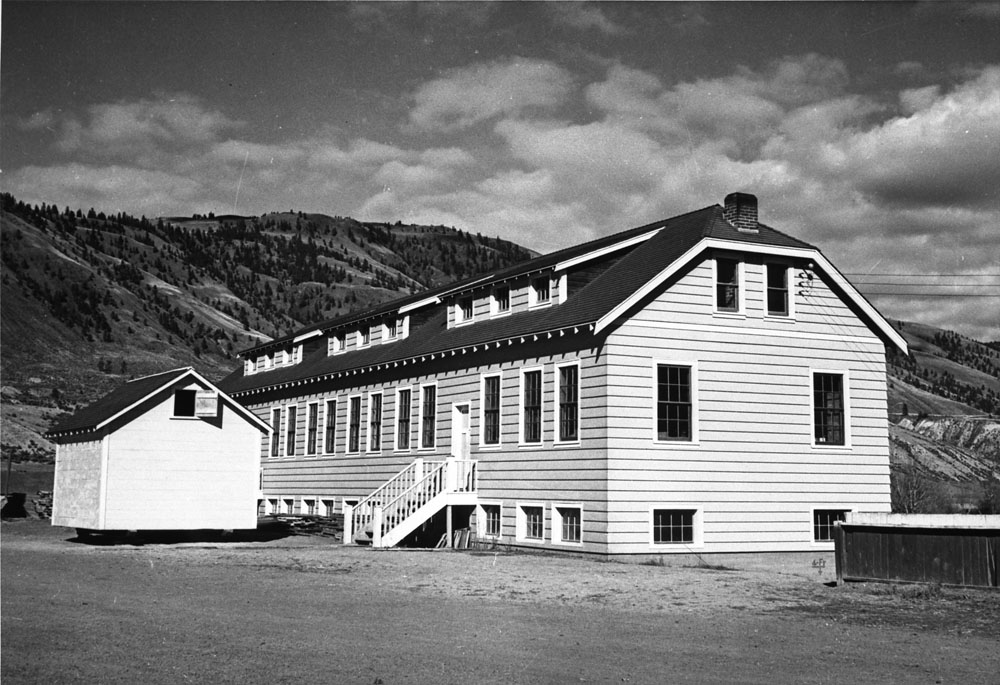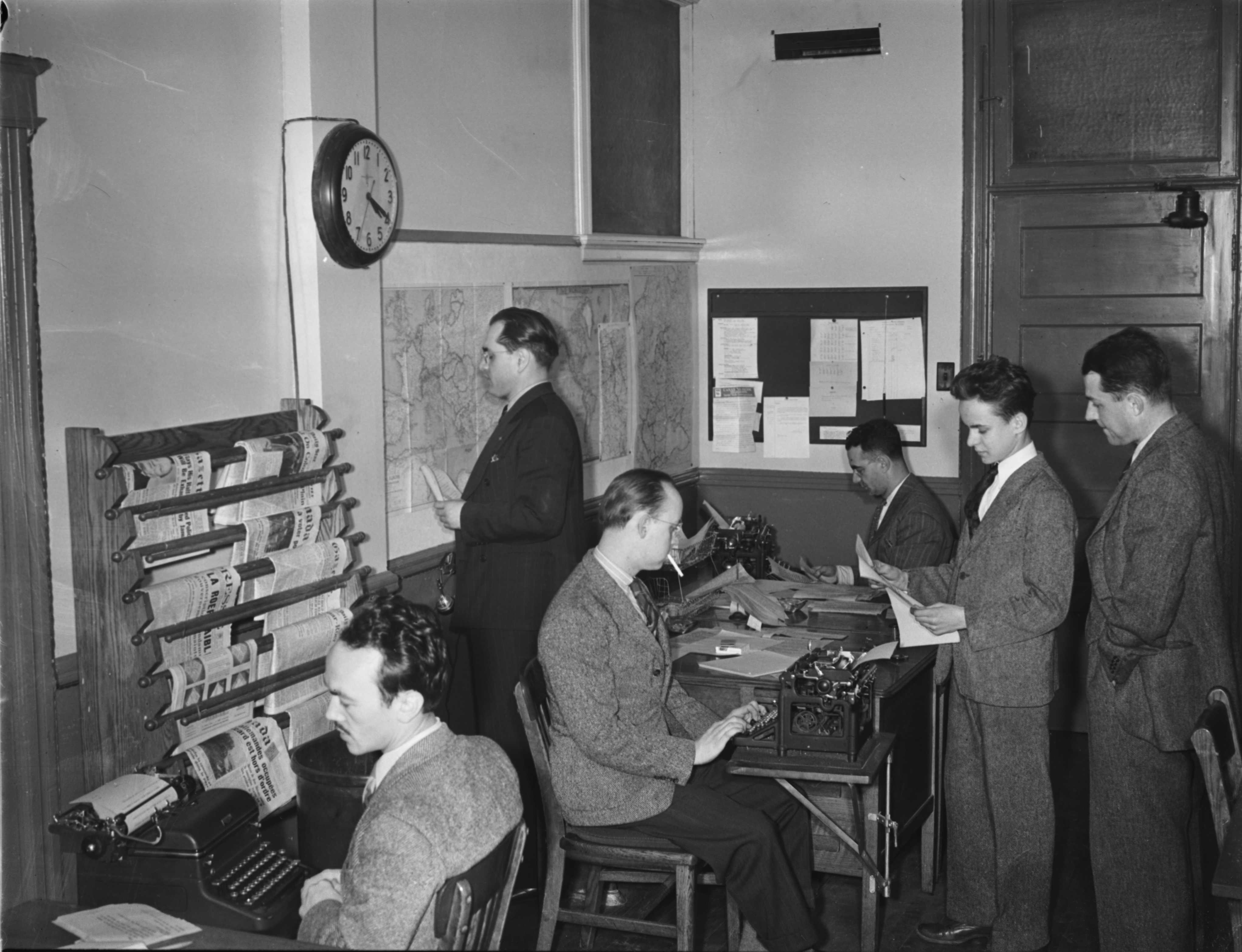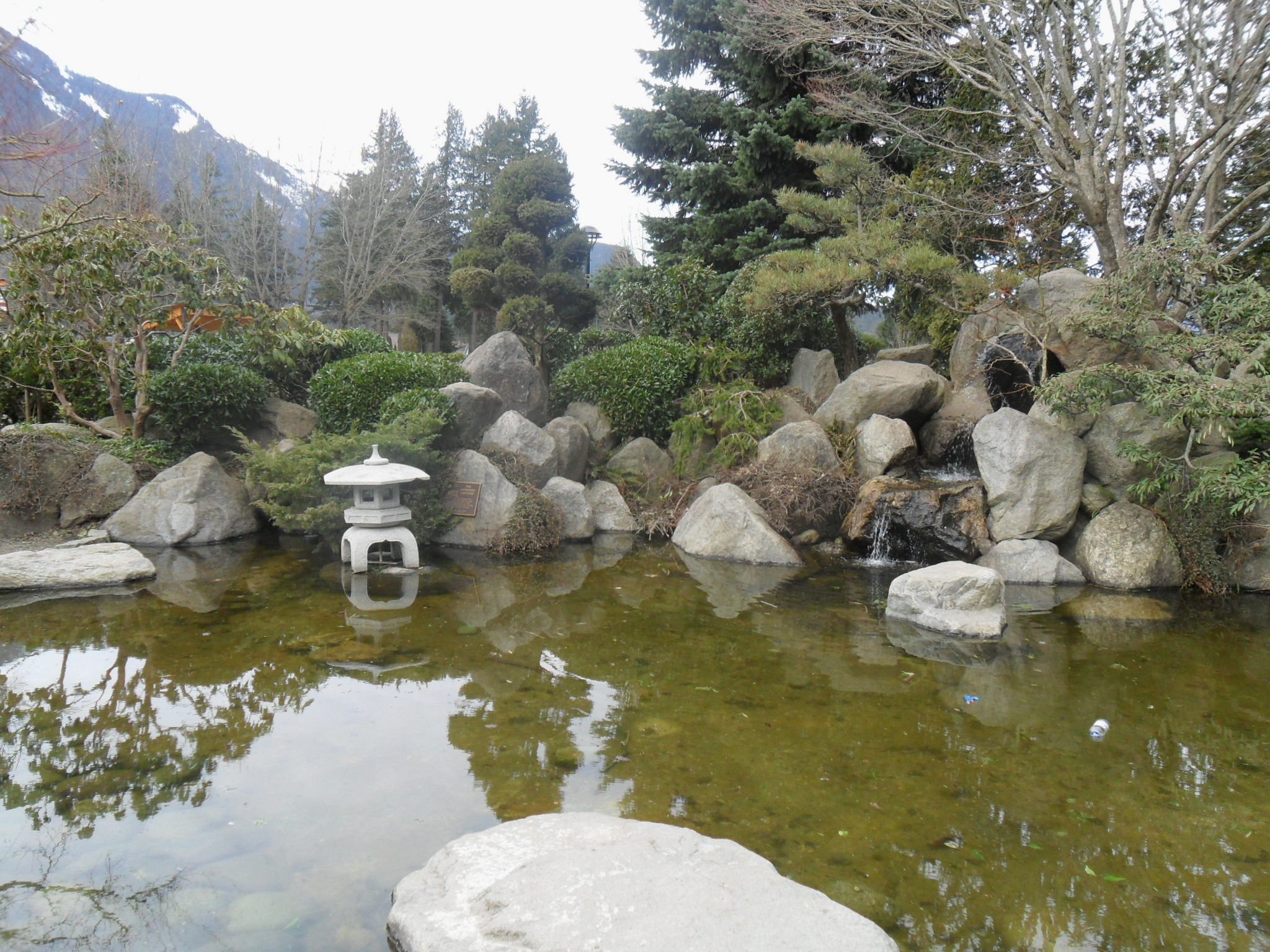|
Kamloops Indian Residential School
The Kamloops Indian Residential School was part of the Canadian Indian residential school system. Located in Kamloops, British Columbia, it was once the largest residential school in Canada, with its enrolment peaking at 500 in the 1950s. The school was established in 1890 and remained in operation until 1969, when it was taken over by the federal government from the Catholic Church to be used as a day school residence. It closed in 1978. The school building still stands today, and is located on the Tk’emlúps te Secwépemc First Nation. In the early 2000s, a tourist discovered a juvenile rib in the area, and in the late 1990s a child's tooth was found. In 2021, Sarah Beaulieu—an anthropologist at the University of the Fraser Valley—surveyed the area with ground-penetrating radar and concluded the probable presence of about 200 unmarked graves, though "only forensic investigation with excavation" could confirm if these were actually human remains. As of May 2022, debates ... [...More Info...] [...Related Items...] OR: [Wikipedia] [Google] [Baidu] |
Kamloops
Kamloops ( ) is a city in south-central British Columbia, Canada, at the confluence of the South flowing North Thompson River and the West flowing Thompson River, east of Kamloops Lake. It is located in the Thompson-Nicola Regional District, whose district offices are based here. The surrounding region is sometimes referred to as the Thompson Country. The city was incorporated in 1893 with about 500 residents. The Canadian Pacific Railroad was completed through downtown in 1886, and the Canadian National arrived in 1912, making Kamloops an important transportation hub. With a 2021 population of 97,902, it is the twelfth largest municipality in the province. The Kamloops census agglomeration is ranked 36th among census metropolitan areas and agglomerations in Canada with a 2021 population of 114,142. Kamloops is promoted as the ''Tournament Capital of Canada''. It hosts more than 100 sporting tournaments each year (hockey, baseball, curling, etc) at world-class sports fac ... [...More Info...] [...Related Items...] OR: [Wikipedia] [Google] [Baidu] |
Canadian Broadcasting Corporation
The Canadian Broadcasting Corporation (french: Société Radio-Canada), branded as CBC/Radio-Canada, is a Canadian public broadcaster for both radio and television. It is a federal Crown corporation that receives funding from the government. The English- and French-language service units of the corporation are commonly known as CBC and Radio-Canada, respectively. Although some local stations in Canada predate the CBC's founding, CBC is the oldest existing broadcasting network in Canada. The CBC was established on November 2, 1936. The CBC operates four terrestrial radio networks: The English-language CBC Radio One and CBC Music, and the French-language Ici Radio-Canada Première and Ici Musique. (International radio service Radio Canada International historically transmitted via shortwave radio, but since 2012 its content is only available as podcasts on its website.) The CBC also operates two terrestrial television networks, the English-language CBC Television and the Frenc ... [...More Info...] [...Related Items...] OR: [Wikipedia] [Google] [Baidu] |
University Of British Columbia
The University of British Columbia (UBC) is a public university, public research university with campuses near Vancouver and in Kelowna, British Columbia. Established in 1908, it is British Columbia's oldest university. The university ranks among the top three universities in Canada. With an annual research budget of $759million, UBC funds over 8,000 projects a year. The Vancouver campus is situated adjacent to the University Endowment Lands located about west of downtown Vancouver. UBC is home to TRIUMF, Canada's national laboratory for Particle physics, particle and nuclear physics, which houses the world's largest cyclotron. In addition to the Peter Wall Institute for Advanced Studies and Stuart Blusson Quantum Matter Institute, UBC and the Max Planck Society collectively established the first Max Planck Institute in North America, specializing in quantum materials. One of the largest research libraries in Canada, the UBC Library system has over 9.9million volumes among it ... [...More Info...] [...Related Items...] OR: [Wikipedia] [Google] [Baidu] |
1957–1958 Influenza Pandemic
The 1957–1958 Asian flu pandemic was a global pandemic of influenza A virus subtype H2N2 that originated in Guizhou in Southern China. The number of excess deaths caused by the pandemic is estimated to be 1–4 million around the world (1957–1958 and probably beyond), making it one of the deadliest pandemics in history. A decade later, a reassorted viral strain H3N2 further caused the Hong Kong flu pandemic (1968–1969). History Origin and outbreak in China The first cases were reported in Guizhou of southern China, in 1956 or in early 1957. Observers within China noted an epidemic beginning in the third week of February in western Guizhou, between its capital Guiyang and the city of Qujing in neighbouring Yunnan province. They were soon reported in Yunnan in late February or early March 1957. By the middle of March, the flu had spread all over China. The People's Republic of China was not a member of the World Health Organization at the time (not until 1981), and di ... [...More Info...] [...Related Items...] OR: [Wikipedia] [Google] [Baidu] |
George Manuel
George Manuel, OC (February 21, 1921 – November 15, 1989, Secwépemc) was an Aboriginal leader in Canada. Born and raised in British Columbia, he became politically active there and in Alberta. In 1970 he was elected and served until 1976 as chief of the National Indian Brotherhood (known today as the Assembly of First Nations). In 1975 he founded and became president of the World Council of Indigenous Peoples, serving until 1981. Reflecting on his work with indigenous peoples across the Americas, he wrote ''The Fourth World: An Indian Reality'' (1975), exploring the effects of waves of European immigration on these peoples. In his later years, he served as president of the Union of BC Indian Chiefs, 1979 through 1981. Biography Manuel was born to Maria and Rainbow in 1921, on the Secwepemc territory of the Shuswap people in British Columbia. Maria later married Louie Manuel, and George took his stepfather's last name. He was first educated at the Kamloops Indian Residentia ... [...More Info...] [...Related Items...] OR: [Wikipedia] [Google] [Baidu] |
The Vancouver Sun
The ''Vancouver Sun'', also known as the ''Sun'', is a daily broadsheet newspaper based in Vancouver, British Columbia, Canada. The newspaper is currently published by the Pacific Newspaper Group, a division of Postmedia Network. Published six days a week from Monday to Saturday, the ''Sun'' is the largest newspaper in western Canada by circulation. The newspaper was first published on 12 February 1912. The newspaper expanded in the early 20th century by acquiring other papers, such as the ''Daily News-Advertiser'' and ''The Evening World''. In 1963, the Cromie family sold the majority of its holdings in the ''Sun'' to FP Publications, who later sold the newspaper to Southam Inc. in 1980. The newspaper was taken over by Hollinger Inc. in 1992, and was later sold again to CanWest in 2000. In 2010, the newspaper became part of the Postmedia Network as a result of the collapse of CanWest. History The ''Vancouver Sun'' published its first edition on 12 February 1912. The ne ... [...More Info...] [...Related Items...] OR: [Wikipedia] [Google] [Baidu] |
Okanagan Indian Band
The Okanagan Indian Band ( oka, N̓k̓maplqs) is a First Nations government in the Canadian province of British Columbia, located in the city of Vernon in the northern Okanagan Valley. The band is a member government of the Okanagan Nation Alliance. Current chief and council: Chief- Byron Louis Governors-in-council: Allan Louis, Daniel Anthony Wilson, Garett Johnny Lawrence, Leland Wilson, Shawna Whitney, Sheldon Louis, Dean Louis, Valerie Chiba, Cindy Brewer, Tim Issac, Population As of October 2010, 809 of the Okanagan Band's population live on one of the band's own reserves, 430 men and 379 women, with 86 people living on reserves governed by other bands (36 men, 50 women). 900 people are living off-reserve. The band's total population is 1,795. Indian Reserves Indian Reserves under the administration of the band are: * Duck Lake Indian Reserve No. 7, on the north shore of Ellison Lake and on the banks of Vernon Creek, 179.10 ha. * Harris Indian Reserve No. 3, two mile ... [...More Info...] [...Related Items...] OR: [Wikipedia] [Google] [Baidu] |
Leonard Marchand
Leonard Stephen "Len" Marchand, (November 16, 1933 – June 3, 2016) was a Canadian politician. He was the first person of First Nations status to serve in the federal cabinet, after being the first Status Indian elected and serving as a Member of Parliament. He served as Parliamentary Secretary, Minister of State, Minister of the Environment and Senator. ICTMN Staff, "Len Marchand, First Status Indian Elected to Canadian Parliament, Walks On" , ''Indian Country Today'' Media Network, 7 June 2016 Early life Marchand was born in |
Lillooet Indians
Lillooet () is a district municipality in the Squamish-Lillooet region of southwestern British Columbia. The town is on the west shore of the Fraser River immediately north of the Seton River mouth. On BC Highway 99, the locality is by road about northeast of Pemberton, northwest of Lytton, and west of Kamloops. First Nations A main population centre of the Stʼatʼimc (Lillooet Nation), who comprise just over 50 per cent of the Lillooet area residents, it is one of the southernmost communities in North America where indigenous people form the majority. First Nations communities assert the land is traditional territory, having been continuously inhabited for thousands of years. The confluence of several main streams with the Fraser attracted large seasonal and permanent indigenous populations. Situated in the Lower Fountain, the Bridge River Rapids (Sat' or Setl), which blocked migrating salmon, has remained a popular fishing and fish drying site for centuries. Keatley ... [...More Info...] [...Related Items...] OR: [Wikipedia] [Google] [Baidu] |
Mount Currie Band
The Lil'wat First Nation ( lil, líl̓watǝmx), a.k.a. the Lil'wat Nation or the Mount Currie Indian Band, is a First Nation band government located in the southern Coast Mountains region of the Interior of the Canadian province of British Columbia. It is a member of the Lillooet Tribal Council, which is the largest grouping of band governments of the St'at'imc or Stl'atl'imx people (a.k.a. the Lillooet people). Other St'at'imc governments include the smaller In-SHUCK-ch Nation on the lower Lillooet River to the southwest, and the independent N'quatqua First Nation at the near end of Anderson Lake from Mount Currie, which is the main reserve of the Lil'wat First Nation, and also one of the largest Indian reserves by population in Canada. The Lil'wat First Nation's offices are located at Mount Currie, British Columbia, about 5 miles east of Pemberton, British Columbia, which is also located in the Lillooet River valley. Mount Currie is also about 20 miles "as the crow flie ... [...More Info...] [...Related Items...] OR: [Wikipedia] [Google] [Baidu] |
Hope, British Columbia
Hope is a district municipality at the confluence of the Fraser and Coquihalla rivers in the province of British Columbia, Canada. Hope is at the eastern end of both the Fraser Valley and the Lower Mainland region, and is at the southern end of the Fraser Canyon. To the east, over the Cascade Mountains, is the Interior region, beginning with the Similkameen Country on the farther side of the Allison Pass in Manning Park. Located east of Vancouver, Hope is at the southern terminus of the Coquihalla Highway and the western terminus of the Crowsnest Highway, locally known as the Hope-Princeton (Highways 5 and 3, respectively), where they merge with the Trans-Canada Highway ( Highway 1). Hope is at the eastern terminus of Highway 7. As it lies at the eastern end of the Fraser Valley in the windward Cascade foothills, the town gets very high amounts of rain and cloud cover – particularly throughout the autumn and winter. Hope is a member municipality of the Fraser Valley Reg ... [...More Info...] [...Related Items...] OR: [Wikipedia] [Google] [Baidu] |
Penticton
Penticton ( ) is a city in the Okanagan Valley of the Southern Interior of British Columbia, Canada, situated between Okanagan and Skaha lakes. In the 2016 Canadian Census, its population was 33,761, while its census agglomeration The census geographic units of Canada are the census subdivisions defined and used by Canada's federal government statistics bureau Statistics Canada to conduct the country's quinquennial census. These areas exist solely for the purposes of stat ... population was 43,432. Name origin The name Penticton is derived from a word in the Okanagan language. It is conventionally translated as "a place to stay forever" but is actually a reference to the year-round flow of Okanagan Lake through Penticton where it enters Skaha Lake. Differing accounts of the meaning are given in the BC Geographical Names entry for the city: History The site of the city was first settled by the Syilx (Okanagan people), of the Interior Salish languages group,#Breese-Bi ... [...More Info...] [...Related Items...] OR: [Wikipedia] [Google] [Baidu] |



.gif)
.jpg)
.jpg)
_ribbon_bar.png)

.jpg)

